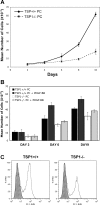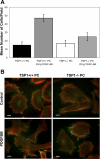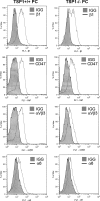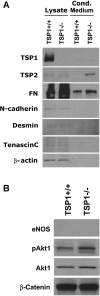Attenuation of proliferation and migration of retinal pericytes in the absence of thrombospondin-1
- PMID: 19193867
- PMCID: PMC2670648
- DOI: 10.1152/ajpcell.00409.2008
Attenuation of proliferation and migration of retinal pericytes in the absence of thrombospondin-1
Abstract
Perivascular supporting cells, including vascular smooth muscle cells (VSMCs) and pericytes (PCs), provide instructive signals to adjacent endothelial cells helping to maintain vascular homeostasis. These signals are provided through direct contact and by the release of soluble factors by these cells. Thrombospondin (TSP)1 is a matricellular protein and an autocrine factor for VSMCs. TSP1 activity, along with that of PDGF, regulates VSMC proliferation and migration. However, the manner in which TSP1 and PDGF impact retinal PC function requires further investigation. In the present study, we describe, for the first time, the isolation and culture of retinal PCs from wild-type (TSP1(+/+)) and TSP1-deficient (TSP1(-/-)) immortomice. We showed that these cells express early and mature markers of PCs, including NG2, PDGF receptor-beta, and smooth muscle actin as well as desmin, calbindin, and mesenchymal stem cell markers. These cells were successfully passaged and maintained in culture for several months without significant loss of expression of these markers. TSP1(+/+) PCs proliferated at a faster rate compared with TSP1(-/-) PCs. In addition, TSP1(+/+) PCs, like VSMCs, responded to PDGF-BB with enhanced migration and proliferation. In contrast, TSP1(-/-) PCs failed to respond to the promigratory and proliferative activity of PDGF-BB. This may be attributed, at least in part, to the limited interaction of PDGF-BB with TSP1 in null cells, which is essential for PDGF proliferative and migratory action. We observed no significant differences in the rates of apoptosis in these cells. TSP1(-/-) PCs were also less adherent, expressed increased levels of TSP2 and fibronectin, and had decreased amounts of N-cadherin and alpha(v)beta(3)-integrin on their surface. Thus, TSP1 plays a significant role in retinal PC proliferation and migration impacting retinal vascular development and homeostasis.
Figures










References
-
- Buzney SM, Frank RN, Robison WG Jr. Retinal capillaries: proliferation of mural cells in vitro. Science 190: 985–986, 1975. - PubMed
-
- Buzney SM, Massicotte SJ, Hetu N, Zetter BR. Retinal vascular endothelial cells and pericytes. Differential growth characteristics in vitro. Invest Ophthalmol Vis Sci 24: 470–480, 1983. - PubMed
-
- Campochiaro PA Molecular targets for retinal vascular diseases. J Cell Physiol 210: 575–581, 2007. - PubMed
-
- Canfield AE, Sutton AB, Hoyland JA, Schor AM. Association of thrombospondin-1 with osteogenic differentiation of retinal pericytes in vitro. J Cell Sci 109: 343–353, 1996. - PubMed
Publication types
MeSH terms
Substances
Grants and funding
LinkOut - more resources
Full Text Sources
Molecular Biology Databases
Research Materials
Miscellaneous

